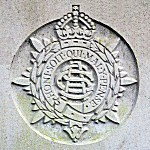Ashtead War Memorials - WWI
Driver Albert Edward Tuckwell
Army Service Corps

Soldiers Who Died in the Great War tells us that Albert Edward Tuckwell was born in Bayswater and a record of this can be traced at Paddington for the June Quarter 1885. He was reported to have continued to live in London but in the 1911 Census he was enumerated in the Epsom District.
His marriage to Elizabeth Emily Chippington [born Frating, Essex? ca 1884], whose name is also indexed for Epsom in the 1911 Census, was registered at Kingston in the September Quarter of that year. The births of three children subsequently appear in Epsom’s registers: - Vera M. 9/1912, Edward G. 12/1913 & Eileen M. 9/1916.
By 1914 he had volunteered at Ashtead for Military Service before being assigned to “1st ICSC, 89 Coy” according to his medal index card. This may be interpreted as “1st Indian Cavalry Supply Column”*, an Army Service Corps unit. 89 Company had been formed in October 1914 about the time that the 1st Indian Cavalry Division sailed from Bombay. This Division arrived in France on 7 November 1914 and Private (otherwise Driver) Tuckwell joined it in the Theatre of War the following 29 November. It would appear that Albert was granted home leave before the Indian Cavalry was re-designated 4th Cavalry Division in November 1916.The Indian cavalrymen spent long periods, as dismounted troops, in the trenches, becoming thoroughly demoralised.
In February 1917, the German forces began a retreat to the strongly fortified Hindenburg Line adopting a 'scorched earth' policy as they went. Clearly AE Tuckwell survived the fierce fighting in the area that lasted from 14 March to 15 April 1917, only to be killed by enemy action a week later.
The CWGC record shows he had was attached to 'M' Anti-aircraft Battery (formed from 40th, 65th, 83rd & 84th Anti-aircraft Sections), presumably as a driver. He died opposing a sector called the Siegfried Stellung (to be distinguished from the Siegfried Line of WWII) which ran from near Arras to St Quentin. He has no known grave and is commemorated on the Arras Memorial.
Divisional Supply Column (89 Coy ASC): National Archives WO 95/1158 January 1917- March 1918. The Corps was not granted a 'Royal' prefix until 1918
http://en.wikipedia.org/wiki/Hindenburg_Line
*The Army Service Corps Motor Transport Companies in the Divisional Supply Columns
Each Division of the army had a certain amount of motorised transport allocated to it, although not directly under its own command. The Divisional Supply Column Companies were responsible for the supply of goods, equipment and ammunition from the Divisional railhead to the Divisional Refilling Point and, if conditions allowed, to the dumps and stores of the forward units. Used, of course, where loads were heavy. A Company initially comprised 5 officers and 337 other ranks of the ASC, looking after 45 3-ton lorries, 16 30-cwt lorries, 7 motor cycles, 2 cars and 4 assorted trucks for the workshop and stores of the Supply Column itself. All Companies served in France unless otherwise mentioned.
text: Brian Bouchard: if you can add to this page please contact
the editor
page added 7 Mar 2009: 28 Nov 17